CH15 - Organizational Culture
- 格式:ppt
- 大小:2.05 MB
- 文档页数:23
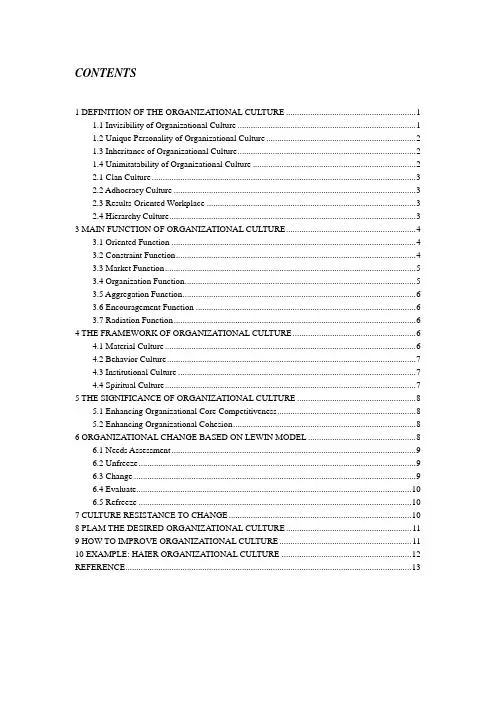
CONTENTS1 DEFINITION OF THE ORGANIZATIONAL CULTURE (1)1.1 Invisibility of Organizational Culture (1)1.2 Unique Personality of Organizational Culture (2)1.3 Inheritance of Organizational Culture (2)1.4 Unimitatability of Organizational Culture (2)2.1 Clan Culture (3)2.2 Adhocracy Culture (3)2.3 Results-Oriented Workplace (3)2.4 Hierarchy Culture (3)3 MAIN FUNCTION OF ORGANIZATIONAL CULTURE (4)3.1 Oriented Function (4)3.2 Constraint Function (4)3.3 Market Function (5)3.4 Organization Function (5)3.5 Aggregation Function (6)3.6 Encouragement Function (6)3.7 Radiation Function (6)4 THE FRAMEWORK OF ORGANIZATIONAL CULTURE (6)4.1 Material Culture (6)4.2 Behavior Culture (7)4.3 Institutional Culture (7)4.4 Spiritual Culture (7)5 THE SIGNIFICANCE OF ORGANIZATIONAL CULTURE (8)5.1 Enhancing Organizational Core Competitiveness (8)5.2 Enhancing Organizational Cohesion (8)6 ORGANIZATIONAL CHANGE BASED ON LEWIN MODEL (8)6.1 Needs Assessment (9)6.2 Unfreeze (9)6.3 Change (9)6.4 Evaluate (10)6.5 Refreeze (10)7 CULTURE RESISTANCE TO CHANGE (10)8 PLAM THE DESIRED ORGANIZATIONAL CULTURE (11)9 HOW TO IMPROVE ORGANIZATIONAL CULTURE (11)10 EXAMPLE: HAIER ORGANIZATIONAL CULTURE (12)REFERENCE (13)ORGANIZITIONAL CULTURE AND DEVELOPMENT OFORGANIZATIONAL CULTURE1 DEFINITION OF THE ORGANIZATIONAL CULTURERavasi and Schultz (2006) state that organizational culture is a set of shared mental assumptions that guide interpretation and action in organizations by defining appropriate behavior for various situations. At the same time although a company may have their “own unique culture”, in larger organizations, there is a diverse and sometimes conflicting cultures that co-exist due to different characteristics of the management team. The organizational culture may also have negative and positive aspects.Schein (2009), Deal & Kennedy (2000), Kotter (1992) and many others state that organizations often have very differing cultures as well as subcultures.According to Needle (2004), organizational culture represents the collective values, beliefs and principles of organizational members and is a product of such factors as history, product, market, technology, and strategy, type of employees, management style, and national cultures and so on. Organizational culture on the other hand refers to those cultures deliberately created by management to achieve specific strategic ends.These definitions express the essence of organizational culture, the organizational cultured is developed with the development of organization. Organizational culture is based on the resources organization owned, which needs to accumulate production and management in the long process. The content of organizational culture includes organizational values, organizational beliefs, organizational spirit, organizational ethics, organizational fashion, organizational democracy and organizational goals.1.1 Invisibility of Organizational CultureOrganizational culture is an ideology, it is a part of the superstructure areas. Thus it is hiding our heart, which is a consensus in the subconscious, marked deeply imprinted in the mind of the staff. Organizational culture into the hearts of the staff goes througha long process, which perish with the enterprise. Enterprises create unique organizational culture in the development, while organizational culture, in turn, promotes the development of the enterprise.1.2 Unique Personality of Organizational CultureOrganizational culture is not formed overnight, it is formed by the unique personality business culture of long-term accumulation. A business idea, a behaviors norm, to get the recognition of all employees is never easy.1.3 Inheritance of Organizational CultureOrganizational culture is formed by developing in certain environments, it is the business to create and practice according to their own criteria, which can be originated in the minority advocacy and demonstration. But the long-standing organizational culture is propaganda, continuing to practice and continuing to regulate results. Organizational culture needs collective wisdom by absorbing, constantly replenishes and revises, gradually forms a continuous self-improvement.1.4 Unimitatability of Organizational CultureOrganizational culture is major enterprise espoused values, these values can only be one for enterprise. Creating an organizational culture can learn the ancient and outstanding organizational culture, so as to cultivate their own organizational culture. But organizational culture is not able to imitate and copy, the hardware resources of organizational culture is not a business, it is the software part of the business, and it was screened in a variety of organizational culture.2 CULRURE TYPESThe competing values framework identifies four distinct types of cultures in organizations.2.1 Clan CultureIt is typified as a friendly place to work where people share a lot of themselves. It is like an extended family with best friends at work. Leaders are thought of as mentors, coaches, and, perhaps, even as parent figures. The organization is held together by loyalty, tradition, and collaboration. Commitment is high. The organization emphasizes the long-term benefits of individual development with high cohesion and morale being important. Success is defined in terms of internal climate and concern for people. The organization places a premium on teamwork, participation, and consensus.2.2 Adhocracy CultureIt is characterized as a dynamic, entrepreneurial, and creative workplace. People stick their necks out and take risks. Effective leadership is visionary, innovative, and risk-oriented. The glue that holds the organization together is commitment to experimentation and innovation. The emphasis is on being at the leading edge of new knowledge, products, or services. Readiness for change and meeting new challenges are important. T he organization’s long term emphasis is on rapid growt h and acquiring new resources. Success means producing unique and original products and services.2.3 Results-Oriented WorkplaceLeaders are hard-driving producers, directors, and competitors. They are aggressive and demanding. The glue that holds the organization together is an emphasis on winning. The long-term concern is on competitive actions and achieving stretch goals and targets. Success is defined in terms of market share and penetration. Outpacing the competition, escalating share price, and market leadership dominate the success criteria.2.4 Hierarchy CultureIt is characterized as a formalized and structured place to work. Procedures andwell-defined processes govern what people do. Effective leaders are good coordinators, organizers, and efficiency experts. Maintaining a smooth-running organization is important. The long-term concerns of the organization are stability, p redictability, and efficiency. Formal rules and policies hold the organization together. Cameron and Ettington’s (1988) review of the literature found more than 20 dimensions of organizational culture, including dimensions such as internal-external focus, speed, riskiness, participativeness, clarity, power distance, masculinity, and individualism. Each of these dimensions helps establish a profile or a pattern for an organization’s culture. By far the three most dominant and frequently appearing pattern dimensions in the literature, however, are cultural strength (the power or preeminence of the culture), cultural congruence (the extent to which the culture in one part of the organization is congruent with the culture in another part of the organization), and cultural type (the specific kind of culture that is reflected in the organization). Cameron & Ettington (1988) found that “the effectiveness of organizations is more closely associated with the type of culture present than with the congruence or the strength of that culture (p.385).”3 MAIN FUNCTION OF ORGANIZATIONAL CULTURE3.1 Oriented FunctionOrganizational culture can play a guiding role for the whole enterprise and every employee’s values and actions. It embodies in two aspects: First, it can guide members’ thinking and behavior; Second, is the overall values and behavior serves as a guide. The latter aspect is even more important. Good organizational culture will be accepted the organizational collective outlooks by staff, so that the complicated rules of petty quiet but seemed less important.3.2 Constraint FunctionOrganizational culture is a silent command, invisible control. Organizational culture plays a binding and normative role for employees of thought, psychological and behavioral. Organizational culture is not bound a system hard constraint, but a softconstraint. Soft constraint is generated based on the cultural and social, any members have a psychological need, and that is based on consciously to obey the fundamental interests of the organization and determine the norms and standards of conduct. The behavior of employees in the enterprise, if it is recognized and praised, you can get psychological balance and satisfaction; on the contrary, it will produce frustration and sense of loss. This constraint will cause strong herd behavior so that the individual groups of psychological pressure and power, so that members produce psychological resonance, then reach behavioral self-control.3.3 Market FunctionMarket is being affected by certain cultural influence and domination, if the organizational culture and the market is not blending, and even conflict, is bound to make business in a difficult and dangerous situation. In a sense, the market competition is a fundamental culture, only organizational culture is adapted to market culture in order to gain the initiative, if the organizational culture is incompatible with the market, they have to adjust to the culture.3.4 Organization FunctionEffective organization, always uses market characteristics and product characteristics freely. The operation is invalid or failed, it is either an unclear understanding of the market, or an unclear understanding of the product , or can not grasp the characteristics to be coordinated. The market is open, a number of similar or even identical products compete in the same market, the result is completely different: some big success,, some failure. Leading to different objective results are differences in corporate culture. Different values, different conduct, different goal-oriented, different controls , different attitudes , different personalities , different working atmosphere in the same condition occurs, which produces a very key difference though it is slight reaction to give birth to an entirely different effect.3.5 Aggregation FunctionAggregation function of organizational culture means that when one set of values is a common recognition by employees, under specific situation, employees through their own personal experience resulting in a sense of pride for their work and mission, the corporate identity and a sense of belonging, so that employees put their thoughts, feelings, behavior linked to the entire enterprise, allowing companies to produce a strong solidarity and cohesion, play a huge overall effect.3.6 Encouragement FunctionOrganizational culture makes member produce a high emotional and energetic and enterprising spirit of the effects from the heart. Corporate culture is as a central content of respect, and people-centered management. In an "everyone is respected," the cultural atmosphere, everyone's contribution will promptly receive affirmation, appreciation and praise, and will not be buried. In this way, employees will always be inspired, always satisfied always have great honor and responsibility, consciously in order to obtain a new, more successful target. Corporate culture meets the multiple needs of employees, and all kinds of irrational need to adjust its constraints. So, positive ideas and conducts will become self-motivated s a ruler for employees form a strong sense of mission, lasting driving force.3.7 Radiation FunctionOrganizational culture is a good group of yeast and a strong radiation. So once the organizational culture is formed a more fixed pattern, it will not only play a role in the enterprise, and have an impact on the employees, but also have an impact on the community through various channels (promotion, communication, etc.)4 THE FRAMEWORK OF ORGANIZATIONAL CULTURE4.1 Material CultureEntrepreneurs engaged in production and operation is the product enterprises created, which is the primary content of the material culture of the enterprise. Also it includesthe business environment, corporate architecture, corporate advertising, products packaging design and so on. Material culture is the carrier of spirit of enterprise material culture, organizational culture is the outermost layer, the outermost layer.4.2 Behavior CultureBehavior culture r efers to employees’ activitie s in production, learning and entertainments, which includes business, educational propaganda, interpersonal, cultural and sports activities. It is a business style, spirit, relationships embodied, but also dynamically reflects of the spirit of enterprise, organizational values. From the process perspective of business operations, including corporate behavior between enterprises, behavior between enterprises and government, behavior between enterprises and the community, businesses dealing with environmental issues on the behavior and so on.4.3 Institutional CultureInstitutional culture is an enterprise to achieve business goals given the behavior of enterprise employees to a certain direction, the way adaptive culture. It is a combination between people and materials, people and institutions in organizational culture. It enables companies in a rapidly changing, complex, fierce competition in the market keeping in a good condition to ensure realization of business goals. It includes content corporate leadership structure, business organization and business management system, which is the foundation and carrier of entrepreneurship and corporate behavior, but also the inevitable presence of material culture.4.4 Spiritual CultureIt is affected by certain social culture background and ideologies during the production process, which becomes a spiritual culture and cultural concept, which is shared management concept and value norms by employees. It is the deep structure in organizational culture building in the organizational culture at the heart of the whole, is an inherent requirement of the people-oriented management and the essence ofsome of the corporate culture. The spirit of organizational culture construction, designed to optimize the quality of employee groups, developed human resources, providing spiritual pillar and source of vitality for the development of enterprises.The spirit of enterprise culture, including the entrepreneurial spirit, business philosophy, business ethics, corporate values, business outlook, business goals and other ideologies.5 THE SIGNIFICANCE OF ORGANIZATIONAL CULTURE5.1 Enhancing Organizational Core CompetitivenessSuccessful organizational culture is necessary to ensure the survival of the enterprise, it enables companies have the ability to self-improvement to improve the core competitiveness of enterprises. Excellent organizational culture makes employees a sense of belonging, a common understanding of the value in order to attract and retain talents in order to improve the competitiveness of business professionals. Outstanding organizational culture can improve the efficiency of business operation, enhance the brand, increase the value of the product, thereby enhancing enterprise competitiveness in the market.5.2 Enhancing Organizational CohesionOrganizational culture is a corporate banner for external, and a centripetal force for internal. Successful organizational culture involves the relationship between individuals and work, to improve the cohesion of the enterprise. Excellent organizational culture within the enterprise can create a fair, trust andgood working environment, each member of the enterprise will take the initiative to make plans for the company and solve problems, simultaneously, employees can realize their maximum value. Excellent organizational culture also helps to improve the overall quality of the staff and help enterprises to adapt quickly to changing markets.6 ORGANIZATIONAL CHANGE BASED ON LEWIN MODELLewin pointed, no matter that individuals, communities or organizations change, itundergoes three stages of unfreeze, change and refreeze. On the basis of Lewin Model, change of organizational culture has five stages: needs assessment, unfreeze, change, evaluate, and refreeze.6.1 Needs AssessmentThis phase requires an external expert to diagnose the existing culture, because the members are impossible to make clear their culture and unbiased analysis. The main task is to collect data, analyze the status determination and the gap between the existing corporate culture and longing states. It accurately reflects the status of the corporate environment, providing companies working in the state to achieve the goal of this process favorable and unfavorable things baseline. Direction of organizational cultural change is reflected in the corporate goals and how to achieve these goals. Needs assessment is a business that needs to be understood in order to achieve the target and the obligation to bear, determine and announce the positive aspects of the business environment and the need to maintain the aspect of organizational culture to recognize and address the barriers formed.6.2 UnfreezeBreak the existing behavior methods and procedures to guide people's attention these fixed procedures, on the basis of needs assessment, to tell people why change occurs. People need to know that in addition to the content changes but also know exactly what happened and why it will be in terms of collaboration, such as how the outcome of the formation of their expectations. People only accept change needs to be added to the change in consciousness to become a supporter and contributor to change.6.3 ChangeOnce thawed existing patterns of behavior, you can change the course of implementation. Changes in corporate culture is remodeling enterprise management system, style and shared values, and is a leader in support of senior managers, the full active participation, new ideas and behavior. Process of rebuilding the psychologicalcontract for employees and enterprises, is a similar process of the formation of organizational culture.6.4 EvaluateIt is critical to evaluate and measure corporate culture change. Evaluation is not only used as an important means to measure achievement, but also a means of intervention, is how people understand the business to success and progress made during the business is making progress. For the results of the evaluation of the role played consolidating and improving; while for mistakes part, play a guiding role to correct.6.5 RefreezeIf an individual or business is in a constant state of change, the aims and objectives can not be achieved. This needs to be a good way to produce change, behavior stabilized, curing psychological procedures for the enterprise as a whole, to become part of a new corporate culture. Refreeze is after the formation of a corporate culture change. Society is evolving among corporate management practices by the challenge of transformation and innovation constantly, employees to pursue the meaning and value are changing. Organizational culture changes in a timely manner, creating higher job satisfaction and generate value business lifestyle. Organizational culture for employees to achieve a subtle influence and control, manage organizational culture change, companies will have a competitive advantage in the knowledge economy.7 CULTURE RESISTANCE TO CHANGEChanging a organizational culture is not easy. Culture emerges out of the shared behaviors and the working relationships of organization members that have developed over time. Consequently, it takes time for a cultural transformation to take effect. Many firms, confronted with international competition and technological change, have no choice but to slim down. Though accelerated by recession, this trend is likely to continue even after economic growth returns.The need for devising and executing better strategies is becoming readily apparent. Recession, deregulation, technological upheavals, social factors, global competition, outsourcing, and markets that seem to suddenly emerge and then vanish just as quickly have increased the pressure on companies to be flexible and adaptable. An inappropriate culture is often one of the biggest stumbling blocks on the path to adaption.8 PLAM THE DESIRED ORGANIZATIONAL CULTUREThe organization must plan where it wants to go before trying to make any changes in the organizational culture. With a clear picture of where the organization is currently, the organization can plan where it wants to be next.Mission, vision, and values: to provide a framework for the assessment and evaluation of the current organizational culture, organization needs to develop a picture of its desired future. What does the organization want to create for the future? Mission, vision, and valuesshould be examined for both the strategic and the value based components of the organization.9 HOW TO IMPROVE ORGANIZATIONAL CULTURE(1) It is an important step towards improving organizational work culture by training employees in the correct way. The rate of conflicts and faults can be brought down considerably when employees know how to do things the right way and what the organization expects from them.(2) One of the best ways to bring about positive changes in the culture of the organization is by analyzing the existing culture and comparing it with the expectations and perceptions of employees. Bring changes accordingly.(3) There is a basic requirement for a productive environment is a diverse team of enthusiastic people, who are interested in working as a team and improving the work atmosphere, as a whole.(4) Discuss with colleagues and talk about matters pertaining to the current culture of the organization. Try to bring in the changes that find justified.(5) Keep healthy communication with team Tell the team members about the leadership of the organization and the strategies adopted to build a more attractive culture in the company.(6) Conflicts are an inevitable part of any organization and have a direct bearing on the health of its culture. How they are handled is an indicator of the prevalent organizational culture. Therefore, when conflicts do arise, the management must settle them quickly and amicably, lest they fester and tensions worsen over time.(7) Create an unbiased, transparent and impartial conflict resolution mechanism. If employees feel they are all being treated equally, they are more likely to accept their mistakes and the judgment of the management, at the end of the conflict resolution exercises.(8) Since the organization is a collection of people, synergy is a must to attain the objectives. Team building is vital in this respect and the management must take the initiative to engage employees in such exercises. They may be fun activities, like sports or games or serious ones, such as projects executed for clients. At the end of the day, such exercises strengthen the spirit of corps and the employee’s allegiance towards the organization, because synergetic and cooperative teamwork is manifest to a healthy organizational climate.10 EXAMPLE: HAIER ORGANIZATIONAL CULTUREHaier president Zhang Ruimin proposed “brand strategy”through technology development, refined management, capital management, mergers and internationalization holding means to make a deficit of 1.47 million enterprises grew rapidly in the country for the 1994 500 ranked number 107, to become the most varieties, the most complete specifications, technical highest export volume of the largest enterprises in Chinese home appliance products group. Zhang thinks she found a shortcut to ch ange the concept of the staff: “We vigorously promote Haier cultural values and behavioral norms, of course, the biggest problem is to let us know and unify the Haier corporate culture goals.”Haier culture is Haier value, the core values is innovation. Haier culture is the conceptof innovation as a precursor to strategic innovation, as the basis for the protection of organizational innovation, as a mean of technology innovation, as a goal of market, along with Haier from small to big, from big to strong, from China to the world, Haier culture itself is also constantly innovated and developed. Generally employees agree that active participation is the biggest characteristic of Haier culture. At present, Haier's goal is to create world famous, winning glory for the nation. The goal combines Haier development and individual values perfectly, every one of Haier employees will be full realization of personal value and pursuit during achieving the goals of the process. Haier culture is not only highly valued by national experts and the media, also by Harvard University and other famous universities in the world put into MBA case base.Haier's corporate culture is divided into three levels: material culture, behavior culture and spiritual culture. The formation of Haier cultural formed a lasting competitive advantage. In featured Haier culture, it extracted from the "shock fish" thinking conducting business. This idea became the Haier culture activated by the low efficiency of the merged enterprise basis.REFERENCEAimee L. Franklin and Javier F. Pagan, Organization Culture as an Explanation for Employee Discipline Practices. Review of Public Personnel Administration ,2006.Schein, Edgar H, Coming to a new awareness of organizational culture. Sloan management review, 1984.William L. Gardner, Brian J. Reithel, Claudia C. Cogliser, Fred O. Walumbwa and Richard T. Foley, Matching Personality and Organizational Culture: Effects of Recruitment Strategy and the Five-Factor Model on Subjective Person-Organization Fit. Management Communication Quarterly 2012 26: 585 originally published online, 2012.Jay B. Barney, Organizational Culture: Can It Be a Source of Sustained Competitive Advantage? Published by University of California, Los Angeles, 1986.。
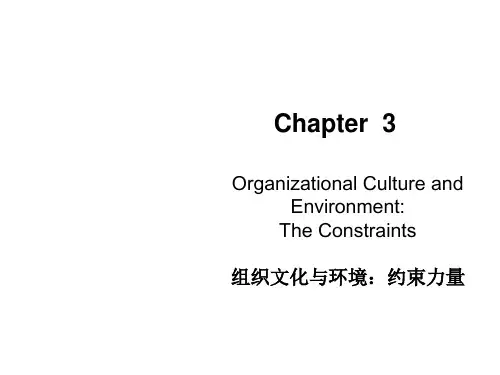
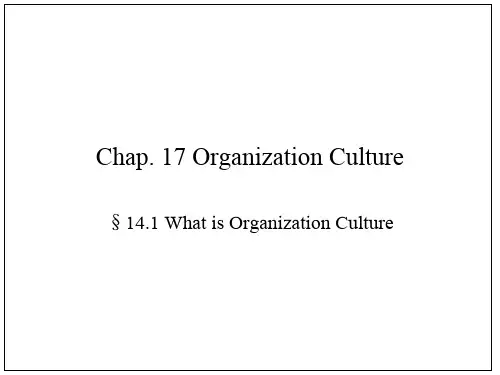
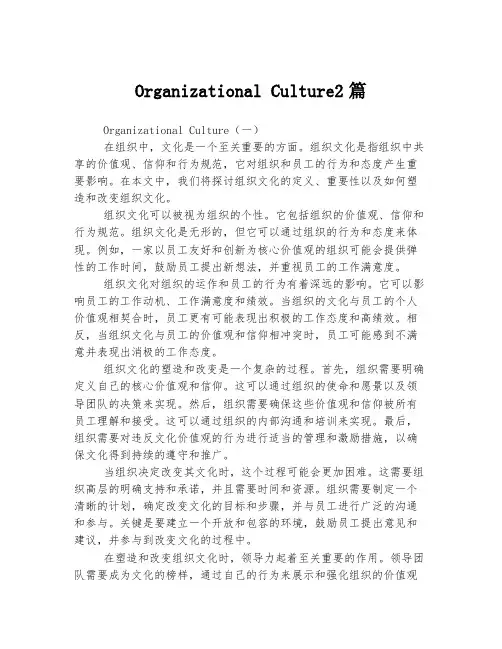
Organizational Culture2篇Organizational Culture(一)在组织中,文化是一个至关重要的方面。
组织文化是指组织中共享的价值观、信仰和行为规范,它对组织和员工的行为和态度产生重要影响。
在本文中,我们将探讨组织文化的定义、重要性以及如何塑造和改变组织文化。
组织文化可以被视为组织的个性。
它包括组织的价值观、信仰和行为规范。
组织文化是无形的,但它可以通过组织的行为和态度来体现。
例如,一家以员工友好和创新为核心价值观的组织可能会提供弹性的工作时间,鼓励员工提出新想法,并重视员工的工作满意度。
组织文化对组织的运作和员工的行为有着深远的影响。
它可以影响员工的工作动机、工作满意度和绩效。
当组织的文化与员工的个人价值观相契合时,员工更有可能表现出积极的工作态度和高绩效。
相反,当组织文化与员工的价值观和信仰相冲突时,员工可能感到不满意并表现出消极的工作态度。
组织文化的塑造和改变是一个复杂的过程。
首先,组织需要明确定义自己的核心价值观和信仰。
这可以通过组织的使命和愿景以及领导团队的决策来实现。
然后,组织需要确保这些价值观和信仰被所有员工理解和接受。
这可以通过组织的内部沟通和培训来实现。
最后,组织需要对违反文化价值观的行为进行适当的管理和激励措施,以确保文化得到持续的遵守和推广。
当组织决定改变其文化时,这个过程可能会更加困难。
这需要组织高层的明确支持和承诺,并且需要时间和资源。
组织需要制定一个清晰的计划,确定改变文化的目标和步骤,并与员工进行广泛的沟通和参与。
关键是要建立一个开放和包容的环境,鼓励员工提出意见和建议,并参与到改变文化的过程中。
在塑造和改变组织文化时,领导力起着至关重要的作用。
领导团队需要成为文化的榜样,通过自己的行为来展示和强化组织的价值观和行为规范。
他们需要与员工进行密切的合作,并提供适当的支持和激励,以确保文化的顺利实施和改变。
总之,组织文化在组织中起着重要的作用。
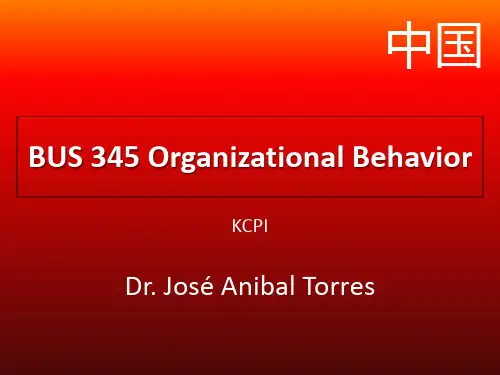
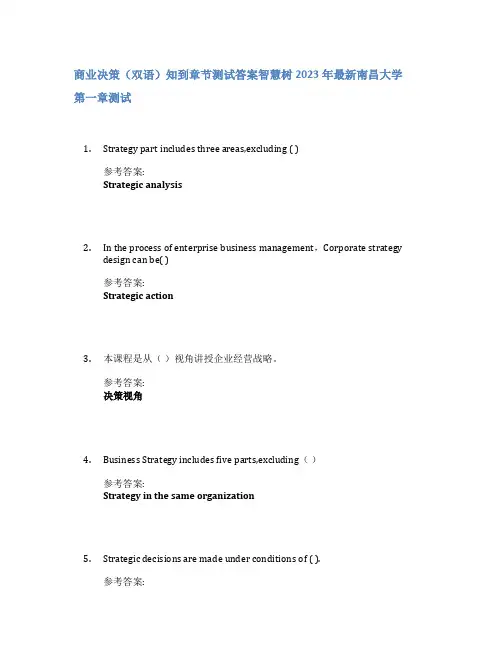
商业决策(双语)知到章节测试答案智慧树2023年最新南昌大学第一章测试1.Strategy part includes three areas,excluding ( )参考答案:Strategic analysis2.In the process of enterprise business management,Corporate strategydesign can be( )参考答案:Strategic action3.本课程是从()视角讲授企业经营战略。
参考答案:决策视角4.Business Strategy includes five parts,excluding()参考答案:Strategy in the same organization5.Strategic decisions are made under conditions of ( ).参考答案:complexity6.The characteristics of strategy exclude( )参考答案:certainty7.一个好的企业的宗旨(使命宣言)主要包括四个方面的内容,其中不包括()参考答案:规模8.企业战略目标的具体表型形式我们常用SMART来表示,其中T代表()参考答案:time bound9.The SMART of objectives,we know the S represents ( )参考答案:specific10.并购包括合并与()参考答案:收购第二章测试1.In environmental issues,study guide includes three parts,excluding( )参考答案:natural environment2.PESTILE represents six key words,and the T represents ( )参考答案:technological environment3.下列属于企业外部利益相关者的是()参考答案:顾客4.Technological environment includes three parts,excluding( )参考答案:environment5.环境保护主要包括六个因素,不包括以下()参考答案:完善环境破坏机制6.The key drivers of environment exclude( )参考答案:government globalization7.The competitive advantage of nations Porter’s Diamond excludes( )参考答案:government conditions8.Poter’s 5 Forces exclude( )参考答案:CONSUMER9.下列属于企业长期目标的是( )参考答案:企业社会责任10.IT on five forces excludes( )参考答案:environment第三章测试1.Dynamics nature of competition excludes( ).参考答案:environment2.The definitions of marketing can be divided into 3 parts,excluding( ).参考答案:dissati sfying the customer’s requirement3.In the following options,Corporate plans exclude( ).参考答案:environment4.In the following options,the marketing mix excludes( ).参考答案:protection5.In the marketing mix ,( )is the first one of Promotion.参考答案:attention6.The key words of consumer goods exclude( )参考答案:price7.In the following options,( )is not the reason of why we segment market orcustomer.参考答案:specific environment8.在管理决策中,许多管理人员认为只要选取满意的方案即可,而无需刻意追求最优的方案。
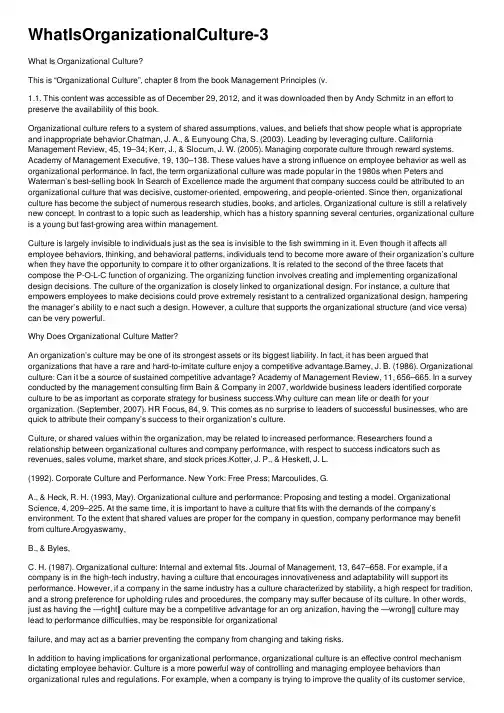
WhatIsOrganizationalCulture-3What Is Organizational Culture?This is “Organizational Culture”, chapter 8 from the book Management Principles (v.1.1. This content was accessible as of December 29, 2012, and it was downloaded then by Andy Schmitz in an effort to preserve the availability of this book.Organizational culture refers to a system of shared assumptions, values, and beliefs that show people what is appropriate and inappropriate behavior.Chatman, J. A., & Eunyoung Cha, S. (2003). Leading by leveraging culture. California Management Review, 45, 19–34; Kerr, J., & Slocum, J. W. (2005). Managing corporate culture through reward systems. Academy of Management Executive, 19, 130–138. These values have a strong influence on employee behavior as well as organizational performance. In fact, the term organizational culture was made popular in the 1980s when Peters and Waterman’s best-selling book In Search of Excellence made the argument that company success could be attributed to an organizational culture that was decisive, customer-oriented, empowering, and people-oriented. Since then, organizational culture has become the subject of numerous research studies, books, and articles. Organizational culture is still a relatively new concept. In contrast to a topic such as leadership, which has a history spanning several centuries, organizational culture is a young but fast-growing area within management.Culture is largely invisible to individuals just as the sea is invisible to the fish swimming in it. Even though it affects all employee behaviors, thinking, and behavioral patterns, individuals tend to become more aware of their organization’s culture when they have the opportunity to compare it to other organizations. It is related to the second of the three facets that compose the P-O-L-C function of organizing. The organizing function involves creating and implementing organizational design decisions. The culture of the organization is closely linked to organizational design. For instance, a culture that empowers employees to make decisions could prove extremely resistant to a centralized organizational design, hampering the manager’s ability to e nact such a design. However, a culture that supports the organizational structure (and vice versa) can be very powerful.Why Does Organizational Culture Matter?An organization’s culture may be one of its strongest assets or its biggest liability. In fact, it has been argued that organizations that have a rare and hard-to-imitate culture enjoy a competitive advantage.Barney, J. B. (1986). Organizational culture: Can it be a source of sustained competitive advantage? Academy of Management Review, 11, 656–665. In a survey conducted by the management consulting firm Bain & Company in 2007, worldwide business leaders identified corporate culture to be as important as corporate strategy for business success.Why culture can mean life or death for your organization. (September, 2007). HR Focus, 84, 9. This comes as no surprise to leaders of successful businesses, who are quick to attribute their company’s success to their organization’s culture.Culture, or shared values within the organization, may be related to increased performance. Researchers found a relationship between organizational cultures and company performance, with respect to success indicators such as revenues, sales volume, market share, and stock prices.Kotter, J. P., & Heskett, J. L.(1992). Corporate Culture and Performance. New York: Free Press; Marcoulides, G.A., & Heck, R. H. (1993, May). Organizational culture and performance: Proposing and testing a model. Organizational Science, 4, 209–225. At the same time, it is important to have a culture that fits with the demands of the company’s environment. To the extent that shared values are proper for the company in question, company performance may benefit from culture.Arogyaswamy,B., & Byles,C. H. (1987). Organizational culture: Internal and external fits. Journal of Management, 13, 647–658. For example, if a company is in the high-tech industry, having a culture that encourages innovativeness and adaptability will support its performance. However, if a company in the same industry has a culture characterized by stability, a high respect for tradition, and a strong preference for upholding rules and procedures, the company may suffer because of its culture. In other words, just as having the ―right‖ culture may be a competitive advantage for an org anization, having the ―wrong‖ culture may lead to performance difficulties, may be responsible for organizationalfailure, and may act as a barrier preventing the company from changing and taking risks.In addition to having implications for organizational performance, organizational culture is an effective control mechanism dictating employee behavior. Culture is a more powerful way of controlling and managing employee behaviors than organizational rules and regulations. For example, when a company is trying to improve the quality of its customer service,rules may not be helpful, particularly when the problems customers present are unique. Instead, creating a culture of customer service may achieve better results by encouraging employees to think like customers, knowing that the company priorities in this case are clear: Keeping the customer happy is preferable to other concerns, such as saving the cost of a refund. Therefore, the ability to understand and influence organizational culture is an important item for managers to have in their tool kit when they are carrying out their controlling P-O-L-C function as well as their organizing function.Levels of Organizational CultureOrganizational culture consists of some aspects that are relatively more visible, as well as aspects that may lie below one’s conscious awareness. Organizational culture can be thought of as consisting of three interrelated levels.Schein, E. H. (1992). Organizational culture and leadership. San Francisco: Jossey-Bass.At the deepest level, below our awareness, lie basic assumptions. These assumptions are taken for granted and reflect beliefs about human nature and reality. At the second level, values exist. Values are shared principles, standards, and goals. Finally, at the surface, we have artifacts, or visible, tangible aspects of organizational culture. For example, in an organization, a basic assumption employees and managers share might be that happy employees benefit their organizations. This might be translated into values such as egalitarianism, high-quality relationships, and having fun. The artifacts reflecting such values might be an executive ―open door‖ policy, an office layout that includes open spaces and gathering areas equipped with pool tables, and frequent company picnics.Understanding the organization’s culture may start from observing its artifacts: its physical environment, employee interactions, company policies, reward systems, and other observable characteristics. When you are interviewing for a position, observing the physical environment, how people dress, where they relax, and how they talk to others is definitely a good start to understanding the company’s culture. However, simply looking at these tangible aspects is unlikely to give a full picture of theorg anization, since an important chunk of what makes up culture exists below one’s degree of awareness. The values and, deeper, the assumptions that shape the organization’s culture can be uncovered by observing how employees interact and the choices they make, as well as by inquiring about their beliefs and perceptions regarding what is right and appropriate behavior.KEY TAKEAWAYOrganizational culture is a system of shared assumptions, values, and beliefs thathelps individuals understand which behaviors are and are not appropriate within anorganization. Cultures can be a source of competitive advantage for organizations.Strong organizational cultures can be an organizing as well as a controllingmechanism for organizations. And finally, organizational culture consists of threelevels: assumptions that are below the surface, values, and artifacts.EXERCISES1.Why do companies need culture?2.Give an example of a company culture being a strength and a weakness.3.In what ways does culture serve as a controlling mechanism?4.If assumptions are below the surface, why do they matter?5.Share examples of artifacts you have noticed at different organizations.8.1 Case in Point: Google Creates Unique CultureGoogle (NASDAQ: GOOG) is one of the best-known and most admired companies around the world, so much so that―googling‖ is the term many use to refer to searching information on the Web. What started out as a student project by two Stanford University graduates—Larry Page and Sergey Brin—in 1996, Google became the most frequently used Web search engine on the Internet with 1 billion searches per day in 2009, as well as other innovative applications such as Gmail, Google Earth, Google Maps, and Picasa. Google grew from 10 employees working in a garage in Palo Alto to 10,000 employees operating around the world by 2009. What is the formula behind this success?Google strives to operate based on solid principles that may be traced back to its founders. In a world crowded with search engines, they were probably the first company that put users first. Their mission statement summarizes their commitment to end-user needs: ―To organize the world’s information and to make it universally accessible and useful.‖ While other companies were focused on marketing their sites and increasing advertising revenues, Google stripped the search page of all distractions and presented users with a blank page consisting only of a company logo and a search box. Google resisted pop-up advertising, because the company felt that it was annoying to end-users. They insisted that all their advertisements would be clearly marked as ―sponsored links.‖ This emphasis on improving user experience and always putting it before making more money in the short term seems to have been critical to their success.Keeping their employees happy is also a value they take to heart. Google created a unique work environment that attracts, motivates, and retains the best players in the field. Google was ranked as the number 1 ―Best Place to Work For‖by Fortune magazine in 2007 and number 4 in 2010. This is not surprising if one looks closer to how Google treats employees. On their Mountain View, California, campus called the ―Googleplex,‖ employees are treated to free gourmet food options including sushi bars and espresso stations. In fact, many employees complain that once they started working for Google, they tend to gain 10 to 15 pounds! Employees have access to gyms, shower facilities, video games, on-site child care, and doctors.Google provides 4 months of paternal leave with 75% of full pay and offers $500 for take-out meals for families with a newborn. These perks create a place where employees feel that they are treated well and their needs are taken care of. Moreover, they contribute to the feeling that they are working at a unique and cool place that is different from everywhere else they may have worked.In addition, Google encourages employee risk taking and innovation. How is this done? When a vice president in charge of the company’s advertising system made a mistake costing the company millions of dollars and apologized for the mistake, she was commended by Larry Page, who congratulated her for making the mistake and noting that he would rather run a company where they are moving quickly and doing too much, as opposed to being too cautious and doing too little. This attitude toward acting fast and accepting the cost of resulting mistakes as a natural consequence of working on the cutting edge may explain why the company is performing much ahead of competitors such as Microsoft and Yahoo! One of the current challenges for Google is to expand to new fields outside of their Web search engine business. To promote new ideas, Google encourages all engineers to spend 20% of their time working on their own ideas.Google’s culture is reflected in th eir decision making as well. Decisions at Google are made in teams. Even the company management is in the hands of a triad: Larry Page and Sergey Brin hired Eric Schmidt to act as the CEO of the company, and they are reportedly leading the company by consensus. In other words, this is not a company where decisions are made by the senior person in charge and then implemented top down. It is common for several small teams to attack each problem and for employees to try to influence each other using rational persuasion and data. Gut feeling has little impact on how decisions are made. In some meetings, people reportedly are not allowed to say ―I think…‖ but instead must say ―the data suggest….‖ To facilitate teamwork, employees work in open office environments where private offices are assigned only to a select few. Even Kai-Fu Lee, the famous employee whose defection from Microsoft was the target of a lawsuit, did not get his own office and shared a cubicle with two other employees.How do they maintain these unique values? In a company emphasizing hiring the smartest people, it is very likely that they will attract big egos that may be difficult to work with. Google realizes that its strength comes from its ―small company‖values that emphasize risk taking, agility, and cooperation. Therefore, they take their hiring process very seriously. Hiring is extremely competitive and getting to work at Google is not unlike applying to a college. Candidates may be asked to write essays about how they will perform their future jobs. Recently, they targeted potential new employees using billboards featuring brain teasers directing potential candidates to a Web site where they were subjected to more brain teasers. Each candidate may be interviewed by as many as eight people on several occasions. Through this scrutiny, they are trying to select ―Googley‖ employees who will share the company’s values, perform at high levels, and be liked by others within the company.Will this culture survive in the long run? It may be too early to tell, given that the company was only founded in 1998. The founders emphasized that their initial public offering (IPO) would not change their culture and they would not introduce more rules or change the way things are done in Google to please Wall Street. But can a public corporation really act like a start-up? Can a global giant facing scrutiny on issues including privacy, copyright, and censorship maintain its culture rooted in its days in a Palo Alto garage? Larry Page is quoted as saying, ―We have a mantra: don’t be evil, which is to do the best things we know how for our users, for our customers, for everyone. So I think if we were known for that, it would be a wonderful thing.‖DISCUSSION QUESTIONS1.Do you think Google has a strong culture? What would it take to make changes inthat culture, for better or for worse?2.Do you think Google’s unique culture will help or hurt Google in the long run?3.What are the factors responsible for the specific culture that exists in Google?4.What type of decision-making approach has Google taken? Do you think this will remain the same over time? Why or why not?5.Do you see any challenges Google may face in the future because of its emphasis on having a risk-taking culture?。
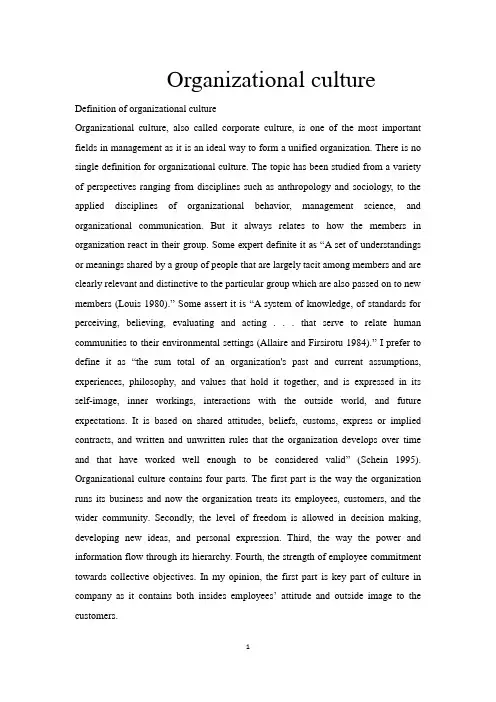
Organizational culture Definition of organizational cultureOrganizational culture, also called corporate culture, is one of the most important fields in management as it is an ideal way to form a unified organization. There is no single definition for organizational culture. The topic has been studied from a variety of perspectives ranging from disciplines such as anthropology and sociology, to the applied disciplines of organizational behavior, management science, and organizational communication. But it always relates to how the members in organization react in their group. Some expert definite it as “A set of understandings or meanings shared by a group of people that are largely tacit among members and are clearly relevant and distinctive to the particular group which are also passed on to new members (Louis 1980).” Some assert it is “A system of knowledge, of standards for perceiving, believing, evaluating and acting . . . that serve to relate human communities to their environmental settings (Allaire and Firsirotu 1984).” I prefer to define it as “the sum total of an organization's past and current assumptions, experiences, philosophy, and values that hold it together, and is expressed in its self-image, inner workings, interactions with the outside world, and future expectations. It is based on shared attitudes, beliefs, customs, express or implied contracts, and written and unwritten rules that the organization develops over time and that have worked well enough to be considered valid”(Schein 1995). Organizational culture contains four parts. The first part is the way the organization runs its business and now the organization treats its employees, customers, and the wider community. Secondly, the level of freedom is allowed in decision making, developing new ideas, and personal expression. Third, the way the power and information flow through its hierarchy. Fourth, the strength of employee commitment towards collective objectives. In my opinion, the first part is key part of culture in company as it contains both insides employees’attitude and outside image to the customers.The role of organizational cultureThere are many practices within an organization that tend to build a unique culture and keep a culture alive and measure the cultural fit between the organization and its employees. Cultural forms function as the linking mechanism by which networks of understanding develop among employees. (Trice and Beyer, 1993) The cultural forms shown in the table on pages 293-94 act as a medium for communicating ideologies, values, and norms. Cultural forms enable leaders to transmit messages about desirable culture to influence thinking and ways of behaving. Cultural forms also address the emotional aspects of organizations that are commonly referred to as cohesion or camaraderie. The organization's culture can be reinforced by many human resource practices such as selection, performance appraisal, training, and career development. Organizational beliefs also tend to influence the work norms, communication practices, and philosophical stances of employees. In the first place, organizations use a socialization process to adapt new employees to the organization's culture. If employees do not adapt well, they feel increasing pressure from supervisors and from coworkers who are better acculturated. They might stay and fight or even leave the organization, voluntarily or involuntarily, and look for a different organization whose culture they fit better. In contrast, employees who understand and share the organization's values have a better basis for making choices that match the firm's goals. Many organizations compete through innovation. Therefore when most employees understand and support the organization's expectations, less time is spent explaining, instructing, and building consensus before trying something innovative. Moreover, the error level will be lower in most cases. Employees who are well acculturated also find their work more meaningful: They are part of, and contribute to, something larger than themselves. Thus, a good cultural fit between employees and the organization contributes to employee retention, organizational productivity, and profit.Comparison of organizational culturesDifferent organizational cultures have different effects on corporations. A goodculture can cheer up the employees and encourage them to work efficiently. However a poor culture tends to limit the talent of employees and bring harm to the corporation. Thus a company’s organizational culture plays a vital role in its success. Therefore how to choose a suitable organizational culture is very vital. An excellent company's culture helps it attract the best talent available people in the industry. Take Google Inc as an example. Google is one of the few companies that has successfully blended technological innovation with strong organizational culture which is very interesting. This culture has helped Google become one of the fastest and most useful web search engines around; it had also helped Google to become one of the top 100 companies to work for according to Fortune (2007). Google maintains a casual and democratic atmosphere and the company do not boast a large middle management. Teams are made up of members with equal authority and a certain level of autonomy is maintained. Google rewards their employee's hard work with an extremely relaxed workplace that encourages creativity through fun activities such as roller hockey and through a casual dress code. Google also encourages their employees to take care of their minds and their bodies by offering them the ability to work out in the gym and get a massage inside the company building. In this way, Google attracts a great deal of highly skilled people to work for it and it encourages them greatly. Germany organizational Culture, another type of organizational culture, is totally different from Google’s. Due to the social culture of integrity and rigorous attitude, German organization tends to do business and train employees in a strict and meticulous way. Employees are expected to tackle problems according to rules and regulations strictly. Enterprise efficiency and social responsibility are the company’s core value. To be more exact, Germany organizational culture inner side is cultivating the teamwork spirit and showing respect to stuff. Outer side is improving product quality and establishing a positive corporate image. With this type of organizational culture, there are several successful companies, such as Siemens, BMW and AUDIConclusionThere is no prefect organizational culture but every company should find their ownsuitable culture to organize their work. An understanding of organizational culture, and how to transform it, is a crucial skill for leaders trying to achieve strategic outcomes. Strategic leaders have the best perspective, because of their position in the organization, to see the dynamics of the culture, what should remain, and what needs transformation. This is the essence of strategic success. Only with a strong and positive organizational culture, can company be successful.BibliographyAliah D Wright. (2009, January). At Google, It Takes A Village To Hire an Employee. HRMagazine: SHRM's 2009 HR TREND BOOK,56-57Allaire, Y. and Firsirotu, M.E. (1984). Theories of oganizational culture. Organization Studies 5(3):193-226Frost, Peter J., Larry F. Moore, Meryl R. Louis, Craig C. Lundberg, and Joanne Martin, eds. Organizational Culture. Beverly Hills, CA: Sage, 1985.Graf, Alan B. Building Corporate Cultures. Chief Executive, 2005, 18.Greg Goth. Googling test practices: Google's culture encourages process improvement).IEEE Software 25.2 p92(3). 2008Louis, M.R. Organizations as culture-bearing milieux. In Organizational Symbolism. Edited by L.R. Pondy, et al. Greenwich, CT: JAI. 1980Ouchi, William G. Theory Z: How American Business Can Meet the Japanese Challenge. MA: Addison-Wesley Publishing, 1982.Schein, Edgar H. Organizational Culture and Leadership: A Dynamic View.San Francisco: Jossey-Bass, 1995.Trice, H. & Beyer, J. 1993, The Cultures of Work Organizations, Prentice Hall, New Jersey.Strategic Leadership and Decision Making: Organizational Culture. [online] Available at:</au/awc/awcgate/ndu/strat-ldr-dm/pt4ch16.html>[Acessed 28 August 2011]。
![高级商务英语听说(第二版)Unit 15 Organizational Culture -Competitive Advantage[精]](https://uimg.taocdn.com/8bb15ee06529647d26285220.webp)
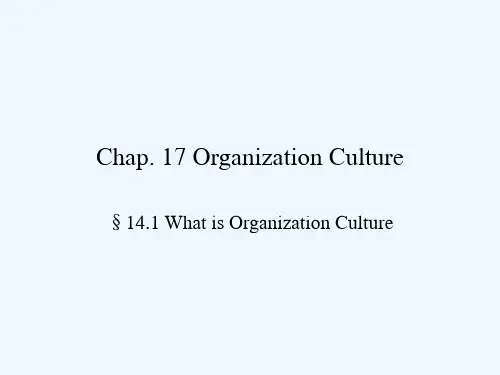
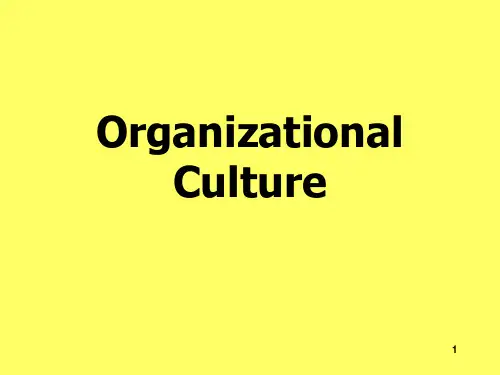
Organizational culture is an organization of its values, beliefs, rituals, symbols, ways of doing things and other components of its unique cultural image. Comes to corporate culture, many operators are considered to be virtual, there is no practical effect, most of the company's corporate culture is often by one person and then an hour summed up according to their own standards, of course, this is made out of the corporate culture by a large problem, did so because they do not really understand the importance of corporate culture, specifically, the corporate culture in general has the following six basic functions: 1, oriented functions: corporate culture can have on business as a whole and corporate values and behavior of members of the orientation of the lead. Specifically manifested have two aspects: First, the members of the company's thinking and behavior of individuals play the guiding role; the second is the overall business management from the values and guiding role. This is because a company's corporate culture, once formed, it set up its own system of values and standards, if a corporate member in the values and conduct orientation and corporate culture have rebelled against the phenomenon of system standards, and corporate culture will be corrected The guide to the corporate values and standards up. 2, the constraint functions: corporate culture on employees of the ideas, the psychological and behavioral binding and normative role. Corporate culture is not bound by the system type of the hard constraints, but a soft constraint, this constraint arises from the enterprise corporate culture, group code of conduct and ethics. Sense of community, public opinion, common customs and habits and other spiritual and cultural content, will result in strong herd behavior of the individual groups of psychological pressure and power, so that member companies have psychological resonance, and then to the behavior of self-control. 3, the cohesion function: cohesion function of corporate culture and values is when a co-sanctioned by corporate employees, it will be a bonding force, from all its members came together to produce a tremendous solidarity and cohesion. By many business relationships in the regulation, including both mandatory "hard control", such as system, and orders; also have to convince educational style "soft regulation", such as public opinion, morality and so on.。
Organizational CultureIn the past 25 years, the concept of organizational culture has gained wide acceptance as a way to understand human systems. From an"open-sytems" perspective, each aspect of organizational culture can be seen as an important environmental condition affecting the system and its subsystems. The examination of organizational culture is also a valuable analytical tool in its own right.This way of looking at organizations borrows heavily from anthropology and sociology and uses many of the same terms to define the building blocks of culture. Edgar Schein, one of the most prominent theorists of organizational culture, gave the following very general definition:The culture of a group can now be defined as: A pattern of shared basic assumptions that the group learned as it solved its problems of external adaptation and internal integration, that has worked well enough to be considered valid and therefore, to be taught to new members as the correct way to perceive, think, and feel in relation to those problems. (Schein 373-374)In other words, as groups evolve over time, they face two basic challenges: integrating individuals into an effective whole, and adapting effectively to the external environment in order to survive. As groups find solutions to these problems over time, they engage in a kind of collective learning that creates the set of shared assumptions and beliefs we call "culture."Gareth Morgan describes culture as "an active living phenomenon through which people jointly create and recreate the worlds in which they live." For Morgan, the three basic questions for cultural analysts are:What are the shared frames of reference that make organization possible? Where do they come from?How are they created, communicated, and sustained? (Morgan 141)Elements of organizational culture may include:Stated and unstated values.Overt and implicit expectations for member behavior.Customs and rituals.Stories and myths about the history of the group.Shop talk—typical language used in and about the group.Climate—the feelings evoked by the way members interact with each other, with outsiders, and with their environment, including the physical space they occupy.Metaphors and symbols—may be unconscious but can be found embodied in other cultural elements.Morgan proposes four essential strengths of the organizational culture approach:It focuses attention on the human side of organizational life, and finds significance and learning in even its most mundane aspects (for example, the setup in an empty meeting room).It makes clear the importance of creating appropriate systems of shared meaning to help people work together toward desired outcomes.It requires members—especially leaders—to acknowledge the impact of their behavior on the or ganization’s culture. Morgan proposes that people should ask themselves: "What impact am I having on the social construction of reality in my organization?" "What can I do to have a different and more positive impact?"It encourages the view that the perceived relationship between an organization and its environment is also affected by the organization’s basic assumptions. Morgan says:We choose and operate in environmental domains according to how we construct conceptions of who we are and what we are trying to do. . . . And we act in relation to those domains through the definitions we impose on them. . . . The beliefs and ideas that organizations hold about who they are, what they are trying to do, and what their environment is like have a much greater tendency to realize themselves than is usually believed. (Morgan 149)According to Edgar Schein, cultural analysis is especially valuable for dealing with aspects of organizations that seem irrational, frustrating, and intractable. He writes, "The bottom line for leaders is that if they do not become conscious of the cultures in which they are embedded, those cultures will manage them." (Schein 375) It is significant that Schein uses the plural "cultures." Using open-systems concepts, we know that members of a group culture may also belong to subcultures within an organization. Since organizations do have a shared history, there will normally be at least a few values or assumptions common to the system as a whole. But sometimes, as in many orchestra organizations, the subcultures have had different experiences over time, and their group learning has produced very different sets of basic assumptions.Organization members interpret the behavior and language of others through their own cultural biases. Each mem ber’s (or subsystem’s) set of beliefs, values, and assumptions becomes their unquestioned "reality"; they then perceive behavior inconsistent with their own biases as irrational, or even malevolent. The organizational culture model suggests reinterpreting such conflict as a product of different sets of experiences. Instead of looking at conflict as "right" versus "wrong," this approach suggests that subsystems examine the assumptions underlying their behavior, honor the experiences and learning that led to those assumptions, and then investigate whether those assumptions still work well in the present.This is an exemplary application of "double-loop" learning, a term coined by Chris Argyris of National Training Laboratories in Washington, D.C., and now in general use among organizational theorists. In contrast with "single-loop" learning, or the process of solving problems based on an existing set of assumptions, double-loop learning also involves becoming aware of a group’s underlying assumption set and co ntinually inquiring whether it is still useful for the task at hand.Because culture is so deeply rooted in an organization’s history and collective experience, working to change it requires a major investment of time and resources. Help from a change agent outside the system is often advisable. Without such help, it is difficult for insiders to view their "reality" as something they’ve constructed, and to see meaning in things they normally take for granted. Next time, we will take a look at ways some organization change practitioners have taken on the challenge of culture change in the corporate world, as well as in the orchestra field. Stay tuned!。